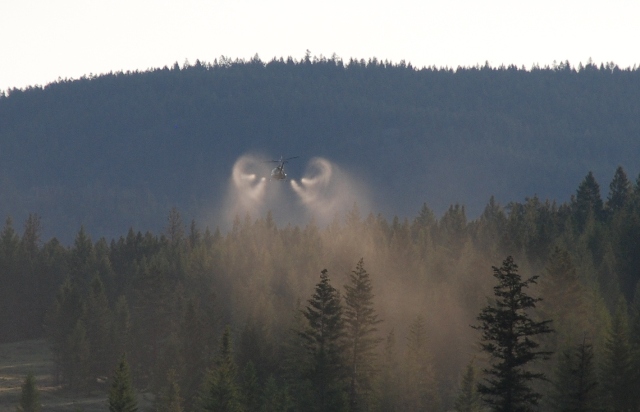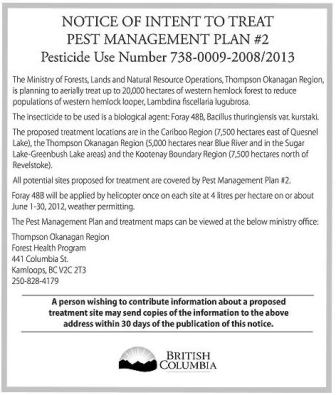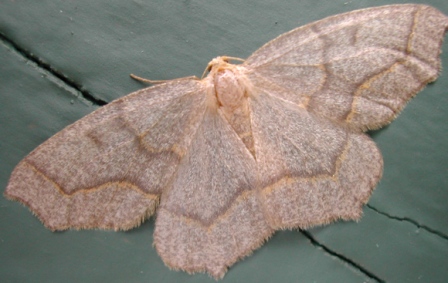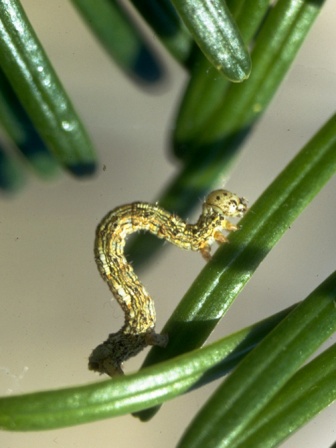

MyValleySun.com is community-based media and we help to improve the quality of life in the communities we serve by providing meaningful online news programming that informs, involves and inspires.
Support Local News
Subscribe - Advertise
Contribute - Purchase
Help us report
the real news...
A store that supports
community-based media
Visit the BullMarket and
support MyValleySun.com
 | ||||

Western Hemlock Looper
Lambdina fiscellaria lugubrosa
Distribution: Primarily occurs south of 56 degrees latitude and is most common along the coast and in the interior wet belt of B.C. Outbreaks have occurred on stands from sea level to 1400 m elevation.
Tree Species Attacked: Western hemlock is the preferred host, but during outbreaks the looper feeds on almost any foliage, including broad-leaved forest trees and shrubs. All ages are susceptible.
Insect Description & Damage Symptoms: Larvae are typical "inch worm" loopers and are approximately 3.5 cm in length when mature. Young larvae are marked with light grey and black bands. Mature larvae are mottled grey to dark brown with an intricate pattern of darker markings. Each abdominal segment is marked with four prominent dark spots, which roughly form a square.
Larvae emerge in late spring and being feeding in newly opened buds in the upper crown. Later, the larvae feed on foliage of any age and disperse throughout the crown. The larvae are wasteful feeders. Many needles are only partially chewed; some are severed at the base and accumulate below an attacked tree. Mature larvae are quite mobile and produce an abundance of silk webbing, which is very evident in defoliated stands. The larvae pupate in late summer in bark crevices, moss, lichen, or in debris on the forest floor. The pupae area mottled greenish-brown, 1.1 to 1.5 cm long. The crowns of heavily attacked trees turn yellowish-red at first and eventually reddish-brown. Defoliation occurs most commonly on sites located in valley bottoms with a major western hemlock component, and is often in distinctive elevational bands.
Damage:
Western hemlock in the interior is intolerant of defoliation; thus, mortality can occur following only one year of heavy defoliation and may continue for up to four years after the collapse of a western hemlock looper infestation. Coastal hemlock seems much more resilient.
Most hemlock can recover from less than 50% defoliation.
The wasteful feeding habit of this insect greatly increases the amount of damage relative to most other defoliators. Older hemlock, amabilis fir, and Sitka spruce are most vulnerable to damage, while young Douglas-fir appears to suffer more than older. Outbreaks generally last for three years. Serious damage has occurred in hemlock/true fir mixes on the coast and hemlock/cedar stands in the interior wet belt of the province.
Similar Damage: Damage is similar to other defoliators, such as the western blackheaded budworm, but the larvae are very distinctive.


big
spray
When our Provincial Government sprays Btk on thousands of hectares that contain the headwaters of the Shuswap River.
Should we care?
Part 2
The Upper Shuswap Rainforest
Under Threat
Understanding the Risks from Loopers, Btk and the Loss of Biodiversity
June 29, 2012
Written and Compiled
by Don Elzer
The Looper is a moth, and Btk will kill it along with other species of moths and butterflies.
Do your own research....
Quick Links
Much of the Btk spray program has been largely unnoticed by the public and media which has grown accustom to believing in the attributes of Btk as an organic solution for combating “pests”, however there are growing reservations associated with both the science and the logic used by government and forest companies to explain such treatments – and the lack of including “biodiversity” in their arguments.
The Cherryville Water Stewards (CWS) wrote a letter to the Ministry of Forests, Lands and Natural Resource Operations (MoF) in order to question the spray program and they received a response from Lorraine Maclauchlan a Forest Entomologist in the Thompson Okanagan Region of the MoF.
My Valley Sun (MVS) has organized the CWS letter with the government response and then we have added further data to the argument by “checking in” with some facts from other sources plus a few comments of our own.
The “Legal Notice” Issue
“…everything was already on the move…”
CWS - First of all, the fact that the legal notice published in The Lumby Times on May 25th was printed six days before the alleged possible beginning of the spraying is a travesty. Obviously everything was already on the move and practically no one had enough time to “contribute information” that would have been taken seriously.
MoF - According to the requirements by Ministry of Environment for Pest Management Plans under the Integrated Pest Management Act and Regulations, notification of aerial treatments of biological insecticides on crown forests is not required. The only public advertising requirement in the regulation is to advertise the Pest Management Plan (PMP) itself when an application for a PMP is made. For reference, here is the link to the current Southern Interior PMP
As this is not considered to be good public relations, the MFLRNO’s Thompson/Okanagan Region decided to publicly advertise all of its defoliator treatment programs and release numerous information bulletins in areas near proposed treatment sites.
Although the advertising stated that the treatment could occur after June 1st, the likely treatment date is later in the month but at the time of advertising it was unclear what this date would actually be. Due to the unseasonably cool and wet spring, I anticipate the treatment may not occur until the end of June or early July. Please refer to the MFLNRO’s western hemlock looper program web page for more information on proposed treatment dates when they become available (note: no dates have been posted yet as the optimum treatment time has yet to be confirmed.)
Note that the advertising is not for contributing information, only notification as a courtesy of an impending treatment. The opportunity for appeals has long since passed and should have been done during the public review period for the PMP and directed at the Environmental Appeal Board.
Checking In – MVS never received advertising notification from the province. The government relies on the public notification plans as being their link to public consultation. Outside of these notifications there are very few government-to-community conversations about such matters and mainstream media has little interest in proactiviely researching the details of such notifications – they largely report word for word accompanying press releases. There is no longer an Okanagan Shuswap Land Management Plan Monitoring Committee that served as a vehicle for getting representatives from various community interests in the same room with government ministry people in order to create a sounding board on land management issues on crown land.
Non-targeted Insects
“...kill undisclosed amounts of non-targeted insects, ...”
CWS - We are aware that BTK, the main active ingredient in Foray 48B, is allowed on certified organic crops and is still considered a biological insecticide harmless to humans since it has been sprayed over urban areas. Our main concern is based on the large scale of the spray zone and the horrendous quantity of this insecticide to be used directly over the headwaters of the Shuswap River watershed, which includes protected areas, the Interior Rain Forest, the Monashee Provincial Park, etc. Since usually several sprays are required to have an impact, you would certainly succeed in delaying the looper’s spread but also kill undisclosed amounts of non-targeted insects in the process, thus negatively affecting entire ecosystems.
MoF - The size of the proposed treatment blocks is relatively small compared to the total size of the watersheds. There will be mortality of some non-target lepidopteron larvae if they are in a vulnerable life stage (usually early stage caterpillars). Susceptibility to Btk is also variable by species. Studies have shown that re-population of niches vacated by the spray are quickly re-filled by populations outside of the spray area if those reservoir populations are healthy. Within two to three years, populations rebound to pre-treatment levels. Furthermore, a four year study of the effects on insectivorous birds associated with the 1999 Victoria gypsy moth spray showed no impacts on bird populations. Sampling will be done in the treated areas and outside the treated areas before and after spraying to determine population levels of hemlock looper and other Lepidoptera larvae.
Checking In – In 2011, researchers for Advanced Spatial Analysis at the UBC Department of Geography stated that the pesticide that poses the most serious threat to butterfly (Lepidoptera) conservation is the otherwise environmentally neutral bacterial insecticide Bacillus thuringiensis variety kurstaki, commonly known as Btk. It is frequently sprayed over thousands of hectares. Btk kills the larvae of all butterflies and moths, although some species are partially resistant to its effects. Any larvae feeding on the outside of leaves, which includes most butterfly larvae, will be affected when Btk is sprayed. Adult butterflies are not affected by spraying with commercial preparations of Btk.
The greatest impact of Btk is on the caterpillars of rare species; they may be completely eliminated from an area treated with Btk. Butterflies and moths of conservation concern are generally poor colonisers, and if there are no nearby populations from which recolonization can occur, they will have been extirpated forever. Controlling Gypsy Moths through Btk spray programs will therefore inevitably have a severe impact on, and likely extirpate, many of the butterflies and moths of conservation concern on southern Vancouver Island and the southern interior. The process may take decades, but it will probably be inexorable if Btk spraying continues to be the control method of choice for pest Lepidoptera species.
Research Link
(Introduction to the Butterflies by Crispin Guppy; Brian. Klinkenberg (Editor) 2011. E-Fauna BC: Electronic Atlas of the Fauna of British Columbia [www.efauna.bc.ca]. Lab for Advanced Spatial Analysis, Department of Geography, University of British Columbia, Vancouver.)
Cumulative Effects
“...the cumulative effects of different bacteria, chemicals and toxins being sprayed are not being monitored”
CWS - We understand the invasive progression of the western hemlock looper can have a damaging impact on the environment, but we doubt that applying 20,000 litres of insecticide on one of the last pristine watersheds in southern BC would actually be part of a better scenario, especially since the cumulative effects of different bacteria, chemicals and toxins being sprayed aren’t monitored.
MoF - Our position, and one that is supported by PMRA and MoE, is that the impacts of Foray 48B should be negligible to the “last pristine watersheds in southern BC”. There are no harmful ingredients in Foray 48B. The product contains 2.1% Btk (spores and crystals) that are a naturally found soil borne organism already present in the ecosystem. 7.9% of the formulation contains a mixture of proprietary ingredients included to enhance the efficacy of the spray against the target organisms and it also contains some of the fermentation solids that were used to grow the bacteria (usually of some grain – wheat, oats, barley, or corn). The remaining ingredient is water (90%). All of the ingredients are considered safe for use on certified organic farms. All ingredients were reviewed by the regulator, the Pest Management Regulatory Agency, and by the Organic Materials Research Institute. The “other ingredients” are all considered to be “inert” by the PMRA and US EPA and many of them are commonly found as additives in foods we eat.
We contend there will be more harm to the integrity of the watershed’s ecosystem if we don’t treat. The whole purpose of the project is to protect critical winter range for endangered mountain caribou whose survival is dependent on the availability of arboreal lichens that only grow on live mature trees. We have witnessed the impacts of previous hemlock looper outbreaks that resulted in severe mortality of mature cedar and hemlock resulting in a significant alteration of the forest structure. Salvage logging operations that will likely follow widespread mortality will also impact watershed integrity. A similar treatment occurred in 2003 in the Revelstoke Lake watershed and this was at the request of BC Parks solely for the purpose of protecting mountain caribou habitat.
So, the question comes back for your group to consider, which is the more important resource value: maintaining an irreplaceable mature canopy or saving some unknown quantity of caterpillars whose populations may recover in 2-3 years?
Checking In – If the ministry truly believes that the “whole purpose of the project is to protect critical winter range for endangered mountain caribou,” then does it now that the provincial government has publicly stated that it has abandoned this particular caribou herd and have deemed it extinct?
Or is the caribou herd not extinct?
The caribou have always been considered the canary in the coal mine in our interior rain forests; however they may actually be more than that. They may be symbolic of a growing disconnect that governments and corporations have with understanding the importance of protecting biodiversity and one that demonstrates that there are no government people in the field to know exactly what’s happening in our forests.
Researchers for Advanced Spatial Analysis at the UBC Department of Geography confirmed that Moth larva can cause significant damage to food crops, ornamental trees and shrubs and be forest pests. But they also stated that pesticide use to control these larva, affects not just the target species but also the larva of all species within the targeted area. Lepidoptera and their larva are a very large order of insects with moths comprising the vast majority in BC and are a major food source for birds, bats, rodents, reptiles, fish and spiders so their importance for a healthy ecosystem cannot be undervalued.
Another area of conservation concern is the lack of available detailed data for moths in general. Some of our best data is only for those species considered to be pests of forest or agriculture where there is a financial profit loss equation. Without detailed data it is extremely difficult to understand which species are disappearing, and which are steady or increasing in numbers and, therefore, the viability of certain species may be in jeopardy without us being aware of it.
As with all creatures, habitat loss is the primary concern - for moths this is no exception.
With roughly 2,000 moth species represented in BC, the habitat they prefer or require can be extremely varied and specific. Some species of moths require little in the way of specific habitat and are quite prolific over a wide range; while other species can only be found sporadically, often only in small niches were their specific requirements can be found. Some of these specific requirements can be in the form of larval food plant availability, shelter from difficult conditions, such as wind, rain, snow, sunshine or shade. Many of these niche habitats are extremely complex and poorly understood and, therefore, it is a greater challenge to preserve them.
The moth life cycle is a shooting gallery of predators and parasites from the moment the female moth lays her eggs to the time when the life cycle is complete. Eggs, depending on the species, are laid by the female in a variety of ways. They are either spread loosely over vegetation, adhered singly to leaves or bark or adhered in clusters to leaves or twigs. Once laid, they have no significant defense other than to blend in with their surroundings as best they can. This can be in the form of coloration, texture or stealth placement by the female.
When laid, these eggs become a ready food source for birds, beetles and other insects as well as becoming targets for parasitic wasps. The rate of parasitization within certain species can be extremely high often approaching 100%, so most of these eggs never reach the larval stage. For those larva that emerge from the eggs unscathed, they face a further battalion of birds, beetles and predatory wasps, such as Yellow Jackets or Bald Faced Hornets, looking for a fast meal. If they are lucky enough to escape these predators, the larva now face their most insidious-enemies the parasitic wasps and flies.
These wasps and flies lay one or multiple eggs on the larva which, upon hatching, burrow inside the larva. The larva is slowly killed by being consumed from the inside. Adult moths are also at high risk to be eaten by birds, bats, rodents, reptiles, fish, spiders and mammals. In some cases, moths form an important mainstay of their diet.
Research Link
(Moths of British Columbia – Introduction by Rob Vandermoor Brian. Klinkenberg (Editor) 2011. E-Fauna BC: Electronic Atlas of the Fauna of British Columbia [www.efauna.bc.ca]. Lab for Advanced Spatial Analysis, Department of Geography, University of British Columbia, Vancouver.)
Guarantee
“Could you, without a doubt, guarantee us that spraying Foray 48B ....won’t negatively alter the integrity of our watershed?”
CWS - Could you, without a doubt, guarantee us that spraying Foray 48B above Sugar Lake, in addition to the other current Pest Management Plans in our area from BC Hydro, Ministry of Transportation, RDNO, Tolko, etc, won’t negatively alter the integrity of our watershed?
MoF - As mentioned earlier, our position, and one that is supported by PMRA and MoE, is that the impacts of Foray 48B should be negligible to the “last pristine watersheds in southern BC”. There are no harmful ingredients in Foray 48B. We can guarantee that NOT treating the area will result in significant changes in the forest structure and “alter the integrity of the watershed”. We also believe, based on the scientific evidence available, that the direct risks of Foray 48B to the rest of the ecosystem are minimal to negligible. There are risks in any endeavour. We have considered the risks against the benefits and have determined that this operation poses minimal risk to the environment and to human health while achieving our tree protection goal.
Checking In – Gaining knowledge and insight into some of the 2,000 plus BC moth species is a life time study with many new species surely to be discovered and insights into life cycles yet to be documented. Similarly, we have very little scientific knowledge regarding the whats under the forest canopy of Upper Shuswap. Any science appears to be based on “tree protection goals” which are more about the industrialized economy than protecting biodiversity.
Not the Last Word
In the Upper Shuswap the risks are high. If the Looper expands its range and remains unchecked it may have catastrophic consequences on rainforest ecosystems. Those consequences may be a natural occurrence as climate change transitions these places into something different.
Conversely, our attempt to mitigate the damage caused by the Looper may have different consequences as we risk damaging food chains and behavior patterns within ecosystems by applying a insecticide that may have unknown consequences.
Is this a choice between two dangerous options? And if it is - are the choices being made by government, scientists or corporations?
What are the motivating factors as decisions are made and can we trust the decision making process?
Greenbush Provincial Park and the Shuswap River Ecological Reserve will both be impacted by the spray. Currently, the province and forest licensees are having their way in this area, might we see a “planned salvage” in this area as a means to harvest more timber?
The Looper can be a serious threat to forest companies or it can be a benefit. It can provide a means by which harvesting can occur in old growth stands – if those stands are threatened by the Looper. The loss or removal of timber is vast when an insect population booms, such has been the case with the Mountain Pine Beetle.
But the decisions about how to manage the Looper might be all about business with biodiversity not being a profitable option.
These issues will grow to become greater threats and perhaps we will all have to depend on communities of people seeking to become stewards in their own forests to protect biodiversity. We will have to depend on our own efforts to become proactive rather than reactive by demonstrating ownership ahead of governments and corporations who seem to be motivated by much different ethics.
The Letter
“… we are appalled by the present aerial spray program…”
The Cherryville Water Stewards is a group of volunteer citizens whose mandate is to preserve and/or improve the purity of the Upper and Middle Shuswap River watershed, for the benefit of its residents and future generations.
The group outlined in their letter to the Forest Health Program which manages the Btk spray efforts that they are appalled by the present aerial spray program (Pesticide Use Number 738-0009-2008/2013) which includes the Upper Shuswap watershed.
In June the Ministry of Forests, Lands and Natural Resource Operations will begin an aerial spray program using helicopters that will cover thousands of hectares surrounding Greenbush Lake and the headwaters of the Shuswap River home to the western edge of BC’s Inland Rainforest.
They will spray this area with a pesticide known as Foray 48B and the target will be the Western Hemlock Looper. The Looper feeds primarily on Hemlock but it can also feed on a variety of other species.
According to some scientists its range and population has expanded vigorously due to climate change.
The province has now expanded the spray program to combat the spruce budworm and includes 10,000 hectares of forest between Midway and Beaverdell and represents Kettle River and Granby River watersheds; and then another 28,000 hectares in the Okanagan Valley.
The spray program will disperse Foray 48B in an insecticide manufactured by Valent BioSciences, which has working relationships with Monsanto. Foray 48B is used in forestry to selectively kill the larval stage of insects called Lepidoptera (moths and butterflies). The active ingredient is Bacillus thuringiensis var kurstaki also known as Btk and is part of a core family of Bacillus thuringiensis substances referred to as Bt.
Bt is a soil-dwelling bacterium that also occurs naturally in the gut of caterpillars of various types of moths and butterflies, as well as on the dark surfaces of plants. When Bt is extracted it is commonly used as a biological pesticide; alternatively, the Cry toxin may be extracted from Bt, which can then be used as part of a chemical pesticide.
Central to this event is a key question - Will this spray program impact bio-diversity?
re-cap
The Main Question
part two
- This photo is a tributary of Valarian Creek near Greenbush Lake, it will be sprayed with Btk this summer.
100 miles

myvalleysun.com
New Ideas About Life and Living in the Okanagan

New Ideas About Life and Living in the Okanagan
We update this website on a regular basis.
 | ||||
Support MyValleySun.com
Help us report on the news that impacts life in the Monashee.

Pledge to My Valley Sun for More News Support
Tip the Balance
Support Real News